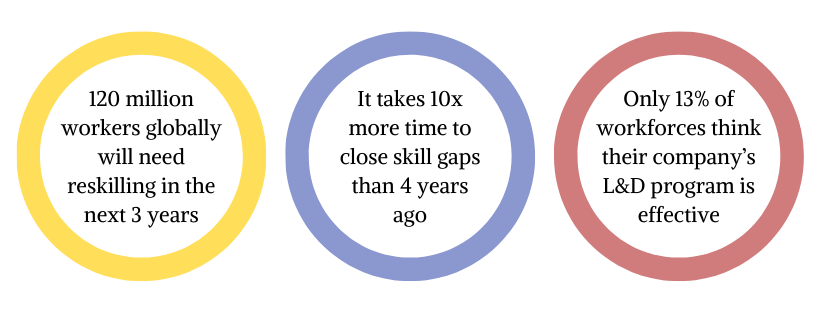A Guide to the NRF Big Show 2023 – Key Trends and Takeaways for Retailers
Business Leaders’ Top 3 Fears
“It’s Halloween, everyone’s entitled to one good scare.” But is it only on Halloween, and is it only about one good scare? Most leaders would disagree.
The number of challenges and risks companies are facing today is huge. From losing key customers and dealing with ever-changing regulations to lagging behind when it comes to innovations and a decrease in competitive ability – leaders have got a lot to worry about.
The fear of failure is strong, but there’s one thing that defines a successful leader: the ability to accept fears and turn them into power. On the eve of Halloween, let’s tackle leaders’ three biggest fears and together find ways to conquer them.
Dead-tech monster: Realizing you’re not digital when you thought you were
Digital transformation still sends shivers down the spine of many leaders. It seems like this is something everybody is talking about, but only a few know how to go about it. The thing is that “digital transformation is not just a technology deployment or an IT exercise, it’s a people exercise,” as Cindy Rose, Microsoft UK Chief Executive, accurately pointed out.
At its core, digital transformation covers every business aspect and process and requires a company to go through several stages to begin operating in a ‘digital’ mode. Unfortunately, some companies either don’t know about all the phases or don’t understand what it takes to become truly digital. Deloitte’s analysis shows that, for the majority of businesses, their digital journey stops at the ‘doing’ digital phase.

The ‘doing’ digital phase creates the illusion of a successful adaption to the digital transformation environment when, in fact, it is not. During this stage, companies usually leverage new technologies to increase operational efficiency but don’t change the traditional business model, culture, or talent development. This is a mistake that doesn’t allow companies to drive business success. To thrive in the age of digital transformation, it’s pivotal to have both digital tools and a digital mindset. Together, they create a smart digital ecosystem, reshaping business processes, customer journeys, and workforce experience.
Left to survive: The shelf life of skills keeps shrinking at a frightening speed
Obsolete and irrelevant skills are not a nightmare, they are the reality. Studies by IBM and Personnel Today keep proving this.

The ever-changing business world calls for ever-changing skills. Unfortunately, companies are not fast enough to introduce tools and resources that would help their workforces absorb new knowledge quickly and effectively. Taking into account the distributed nature of work, it becomes even more difficult.
To tame the ravenous monster that devours more and more skills with each passing day, shortening their lifespan, leaders have to leverage smart data-driven tools and optimize their in-house reskilling programs. How can these tools help?
Data-driven learning systems provide companies with real-time insights into what is happening now and what to expect in the future, then prescribing recommended activities to the right team members to prevent any business disruptions. It’s made possible through an ongoing analysis of every individual’s performance data with the subsequent building of personalized learning journeys. These journeys match the right people to the right skills at the right time, making the company’s learning program meaningful and scalable.
Trapped in the CEO bubble: When you hear what you want, not what the state of things really is
Imagine living in a utopian world where everything is always going well. Leaders know what’s happening at their companies, they’re well-acquainted with every little detail that matters to their brand, and they always know what to do. Unfortunately, the reality is far from this perfect picture.
Most leaders have been trapped in a so-called ‘CEO bubble’. This is a situation where the company culture and leader’s mindset make workforces either keep silent about emerging business challenges or hide them, delivering only ‘good news’. In the majority of cases, things quickly escalate and lead to business collapse.
“I’d rather they’re [employees] afraid of what will happen if they stay silent than being afraid of what will happen if they speak up,” said Elon Musk. He believes that the accident with the explosion of SpaceX’s first reusable rocket back in 2016 could have been avoided if all the possible challenges had been discussed.
There are two things leaders can do to escape the CEO bubble. First, foster a positive company culture where open communication is appreciated, be it feedback surveys, discussions, or any other forms of communication. Second, use analytical tools to get real-time insights into what’s happening in a company on the macro and micro levels (operational processes, each individual’s performance progress, etc.). This way, leaders won’t be isolated from their teams and will be able to act proactively in solving looming issues before they turn into big problems.
Fears won’t paralyze you and your company’s success if you have the right tools on hand. By leveraging smart data-driven learning and performance enablement systems, you will be able to deal with any business challenge in the most efficient way.
We’ve got you covered! See how Rallyware’s Performance Enablement Platform can shield your company from monsters and drive business growth.
News and Insights on Workforce Training & Engagement
We’re among top-notch eLearning and business engagement platforms recognized for effective training and talent development, helping to empower distributed workforces
Subscribe
